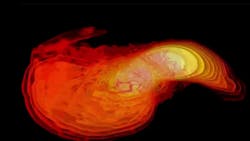LIGO interferometric instruments directly detect cosmic gravitational waves for the first time
After years of measurements, refinements, and waiting by scientists, the twin Laser Interferometer Gravitational-wave Observatory (LIGO) detectors, located in Livingston, Louisiana, and Hanford, Washington, have for the first time directly detected gravitational waves, which are ripples in the fabric of spacetime.1 This confirms a major prediction of Albert Einstein’s 1915 general theory of relativity and opens a new window onto the cosmos.
Measured frequency sweep from 35 to 250 Hz
The gravitational waves were detected on September 14, 2015 at 5:51 a.m. Eastern Daylight Time (09:51 UTC) by both of the LIGO detectors. The signals at both detectors show an upward sweep in frequency from 35 to 250 Hz with a peak gravitational-wave strain of 1.0 x 10-21. The waveform matches what is predicted by general relativity for the merger of two black holes and the subsequent ringdown.
Based on the observed signals, LIGO scientists estimate that the black holes for this event were about 29 and 36 times the mass of the sun, and the event took place 1.3 billion years ago. About 3 times the mass of the sun was converted into gravitational waves in a fraction of a second, with a peak power output about 50 times that of the whole visible universe. By looking at the time of arrival of the signals—the detector in Livingston recorded the event 7 ms before the detector in Hanford—scientists can say that the source was located in the Southern Hemisphere.
The discovery was made possible by the enhanced capabilities of Advanced LIGO, a major upgrade that increases the sensitivity of the instruments compared to the first generation LIGO detectors, enabling a large increase in the volume of the universe probed—and the discovery of gravitational waves during its first observation run. The development and refinement of LIGO has pushed the boundaries of interferometric measurement, optical, and laser technology.
(Video: Caltech)
The LIGO Observatories are funded by the National Science Foundation (NSF), and were conceived, built, and are operated by Caltech and MIT. The discovery was made by the LIGO Scientific Collaboration (which includes the GEO Collaboration and the Australian Consortium for Interferometric Gravitational Astronomy) and the Virgo Collaboration using data from the two LIGO detectors.
LIGO research is carried out by the LIGO Scientific Collaboration (LSC), a group of more than 1000 scientists from universities around the United States and in 14 other countries.
More detectors will help locate gravitational-wave sources
"Hopefully this first observation will accelerate the construction of a global network of detectors to enable accurate source location in the era of multi-messenger astronomy," says David McClelland, professor of physics and director of the Centre for Gravitational Physics at the Australian National University.
Source: https://mediaassets.caltech.edu/gwave
Reference:
B. P. Abbott et al., Physical Review Letters (2016); http://link.aps.org/doi/10.1103/PhysRevLett.116.061102
About the Author
John Wallace
Senior Technical Editor (1998-2022)
John Wallace was with Laser Focus World for nearly 25 years, retiring in late June 2022. He obtained a bachelor's degree in mechanical engineering and physics at Rutgers University and a master's in optical engineering at the University of Rochester. Before becoming an editor, John worked as an engineer at RCA, Exxon, Eastman Kodak, and GCA Corporation.

